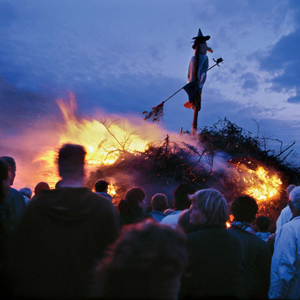Prior to the Scientific Revolution and the Age of Enlightenment, people believed in sorcery to explain misfortune. Evil and wickedness were personified in individuals that people believed consorted with the devil and since female sexuality invited coitus with Satan, women were accused of witchcraft more frequently than men. Historians agree that 85 percent of convicted witches were women.
Witch-hunting was popular in Europe and North America in the 16th and 17th centuries due to the schism within western Christianity that bred spiritual insecurity and mass hysteria. Since the Protestant Revolution and Catholic Counter-Reformation competed for souls, both sides accused the other of encouraging witchcraft. Some historians claim it involved "hundreds of thousands," but a more accurate number is probably closer to 40,000-60,000.
I live in Denmark, and I think about all this every June when Midsummer is celebrated by burning a fabricated witch from the top of a bonfire. Originally, this was supposed to be in remembrance of the unfortunate Lutherans who were persecuted during the 16th and 17th century's wars of religion. Gradually, however, commemoration evidently slipped through the cracks and celebration took over. I've never heard anyone refer to the symbolic witch burning as anything but frivolous fun. "You're not supposed to take it seriously!" is what I hear. OK. But this is not easy to do when some Danish bonfire witches are attached to firecrackers that, when detonated, are supposed to represent her screams.
Am I lacking a sense of humor? Too politically correct? Maybe. But the feminist in me never fails to be offended.
Historically speaking, death by burning combined execution with prolonged, excruciating pain. It is noted by Italian Renaissance historians that the rebel monk, Savonarola was grateful to his executioners when he was informed that he would be executed first by hanging and then burned at the stake.
Unfortunately, burning women is not restricted to history. In the 21st century, it is a form of gender-based violence in India and Pakistan when an insufficient dowry results in an "accident" with a cooking stove.
Other forms of gender-based violence are contemporary and prevalent in both the Western and Eastern halves of the world. In Christian culture, for example, domestic violence is still legitimized in some circles by citing "Biblical authority."
In her book, Your Fatwa Does Not Apply Here, Karima Bennoune offers documented evidence of Islamic fundamentalism's war against women.
Rape, followed by death, has become a common form of modern warfare.
Slut shaming through Western social media results in an increasing number of suicides among teenage girls.
So-called "honor killings" do not usually involve fire but death by beating, stabbing or poisoning.
Horrific and unspeakable brutality perpetrated against women because they are women.
Knowing this makes it all the more disturbing -- and yes, unforgiving -- when a contemporary civilized culture exercises amnesia every summer and forgets the historical significance of burning a woman believed to be a witch.
Midsummer in Denmark is celebrated not on June 21st -- the longest day of the year -- but on June 23rd, the eve of St. John's birthday. Sankt Hans Aften is observed by gathering together on beaches and singing Lutheran hymns. It's a family affair. Little children are dazzled by enormous bonfires as their parents hang out with friends and neighbors, drinking wonderful Danish beer in the glorious twilight of a Scandinavian summer. Someone from the community gives a sentimental speech, and then everybody sings Vi elsker vort land, a nationalistic, yet indescribably moving song that never fails to bring tears to my eyes.
This is good. It is comforting. It serves as effective consolation to the outrage I feel when I see the female figure being burned from the top of the haystack. "See the evil witch," the parents say to the children." "She's being sent to Bloksbjerg.... (and then to add irony) "..... in Germany!" Everybody smiles.
Danes love this event, and the witch burning, as I have said, is not to be taken seriously. But violence against women is screaming to be taken seriously. Angelina Jolie is using her celebrity status to draw attention to rape-as-warfare. The Internet is home to dozens of websites that are campaigning against gender based violence. Everyday Feminism is a good place to start. Another one is UltraViolet Action.
Feminism -- the campaign for women's rights -- is now entrenched in the progressive branches of Islam, Judaism and Christianity.
Maybe it's not too late to use Midsummer and the observance of St. John's birthday as a reminder of women's vulnerable status throughout the world. If Danes don't want to replace the witch figure with something less offensive, maybe they can conjure up a new, relevant, enlightened and socially progressive interpretation. Maybe they can transform the ritual into something that feels good.

